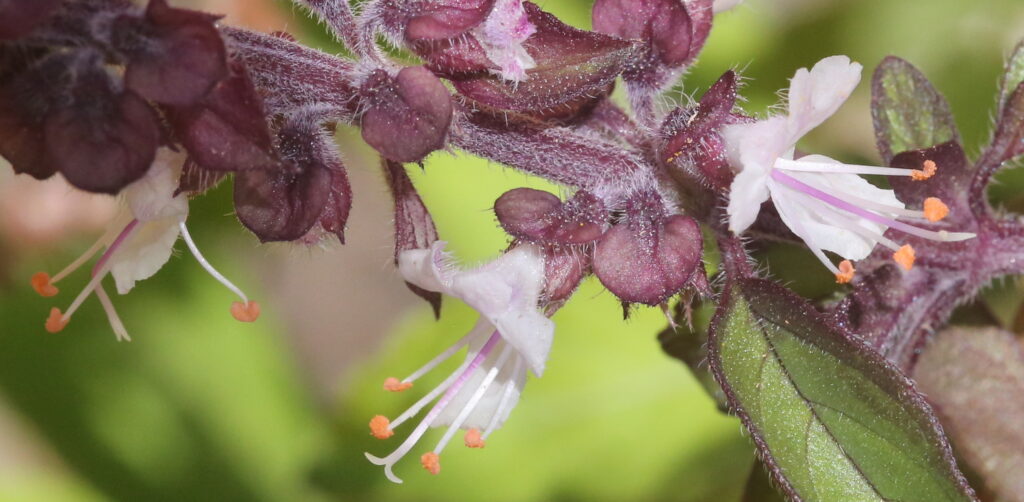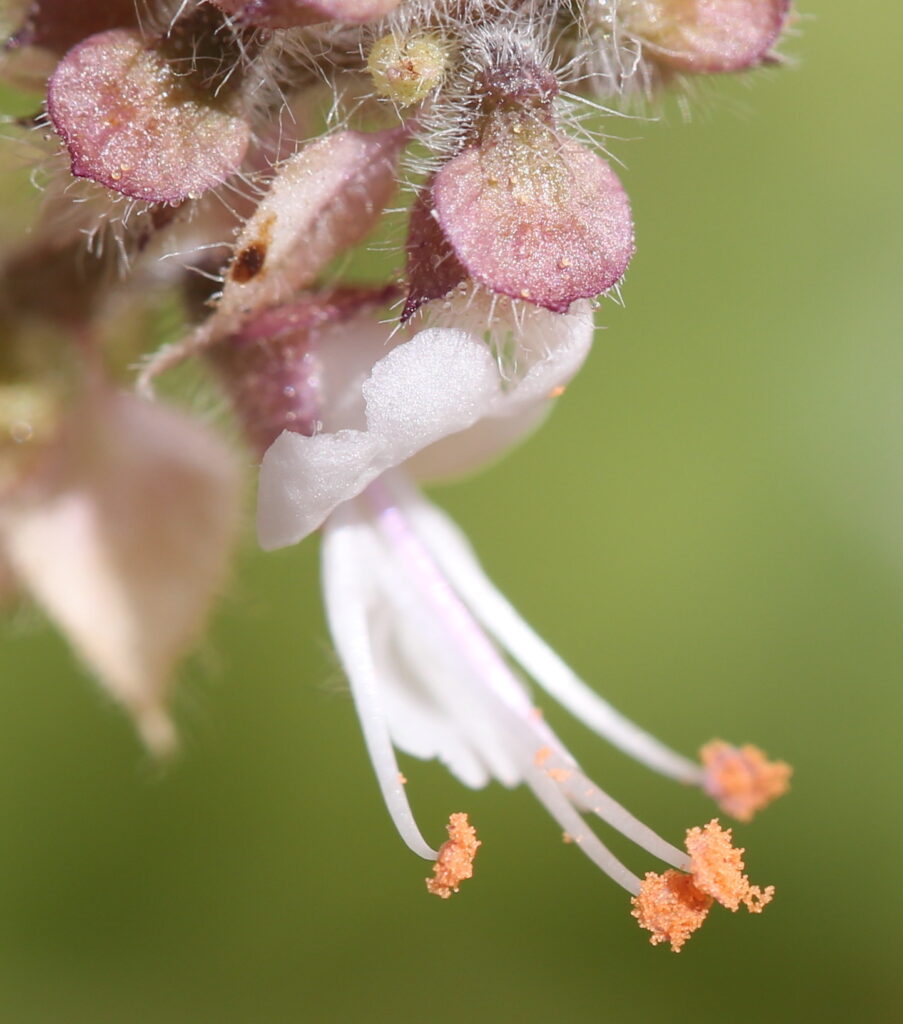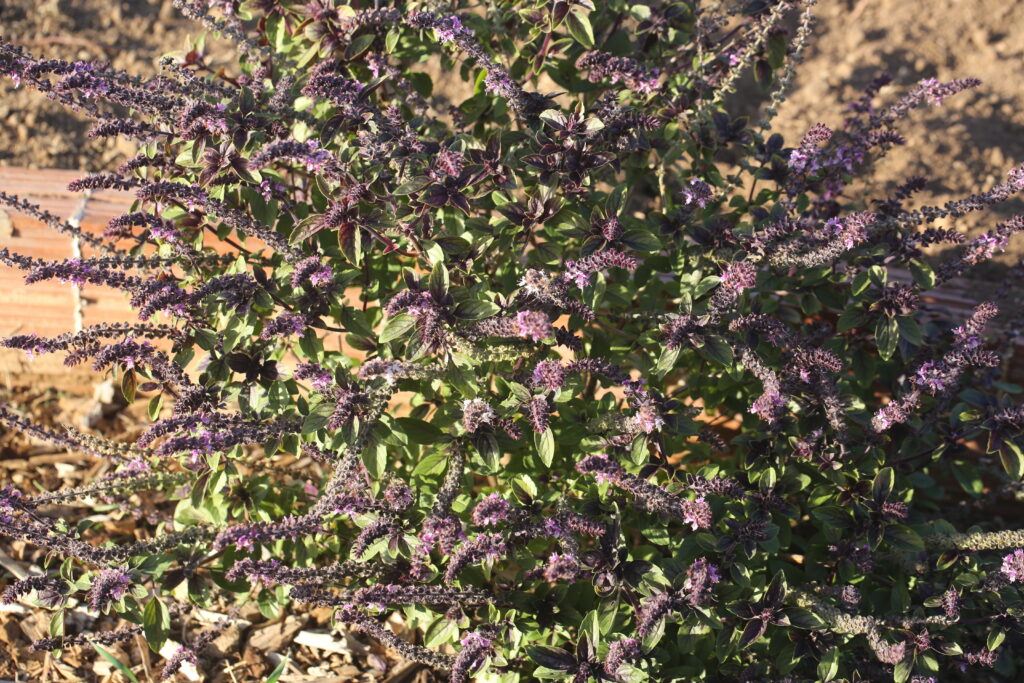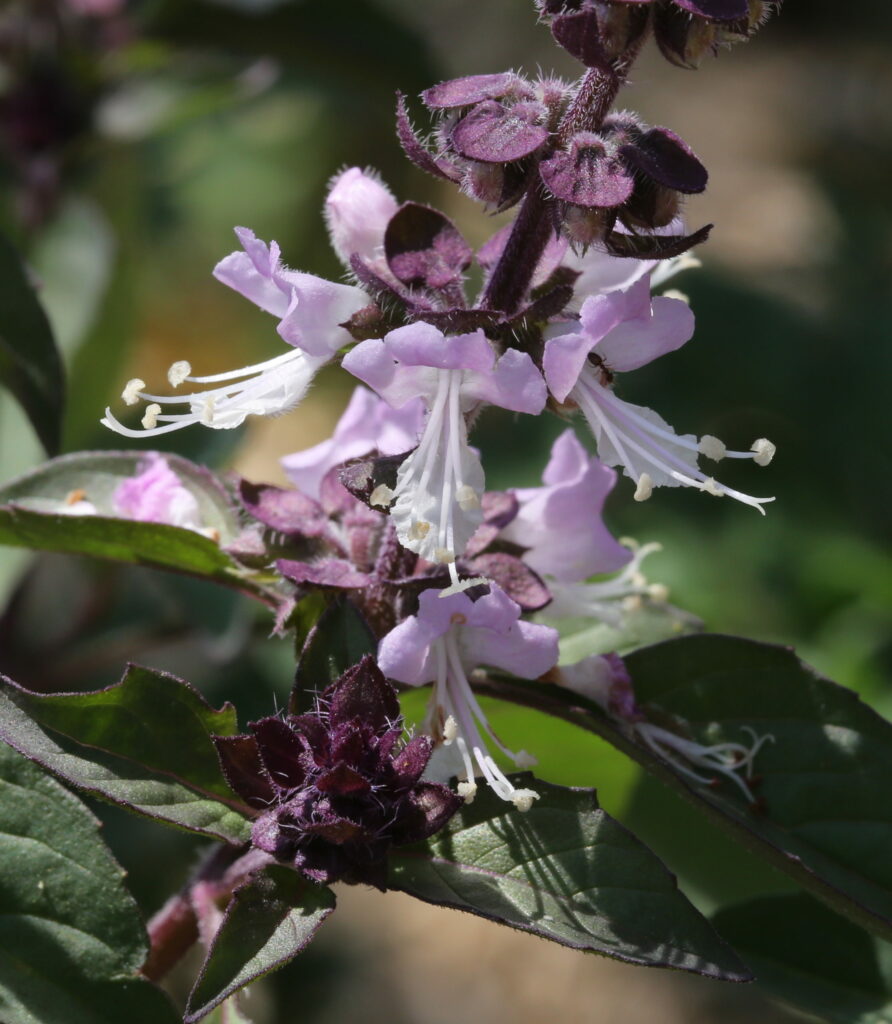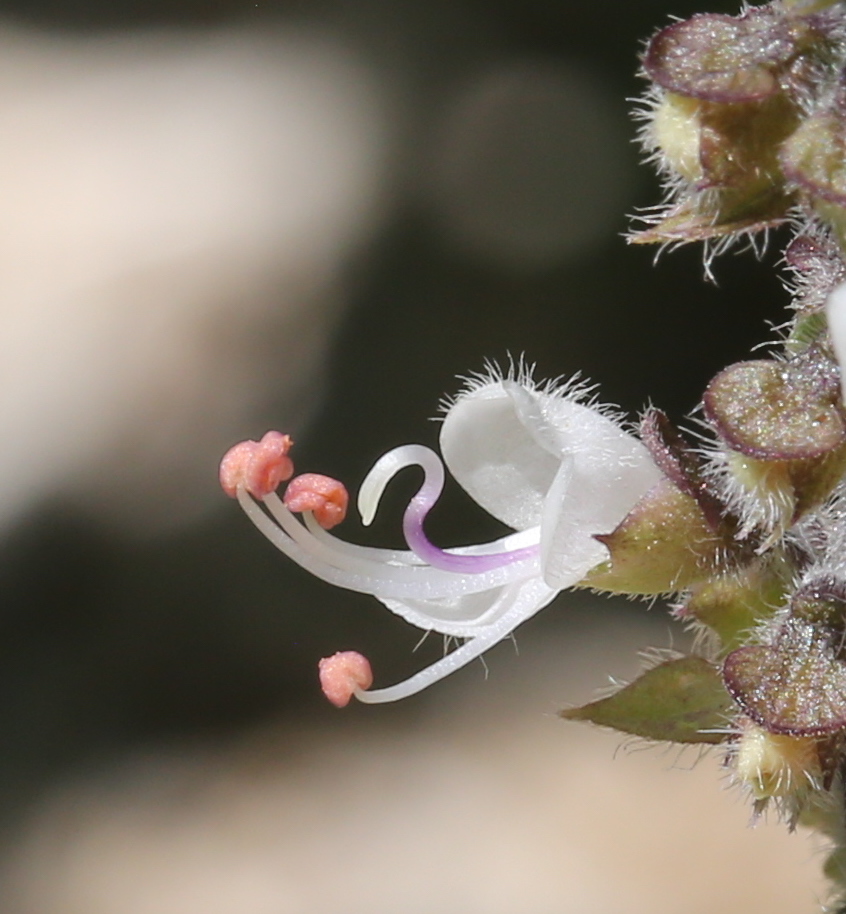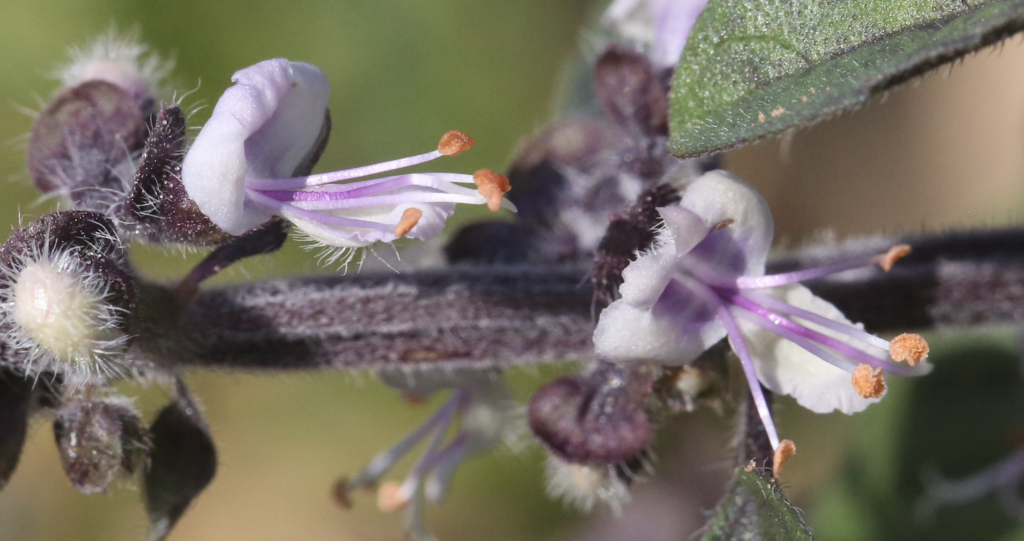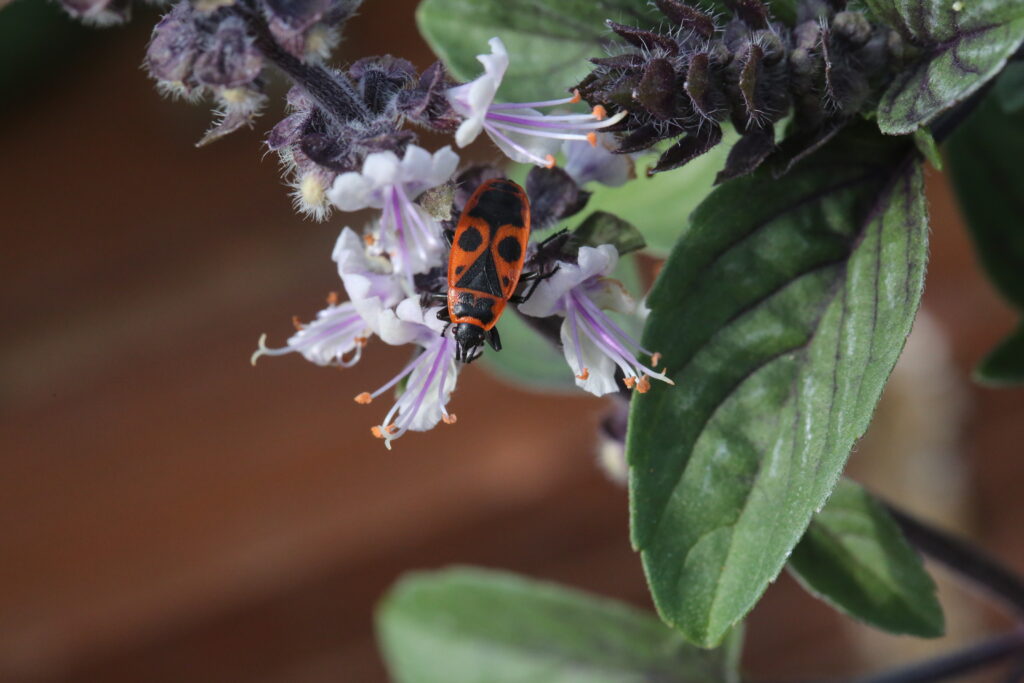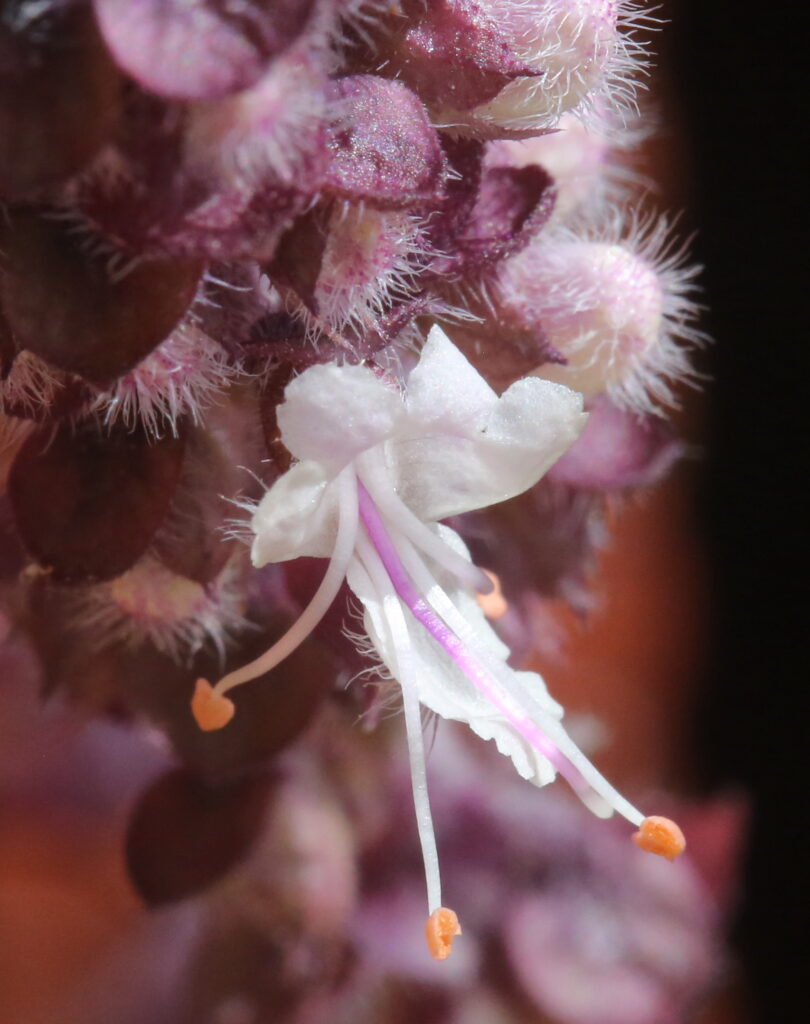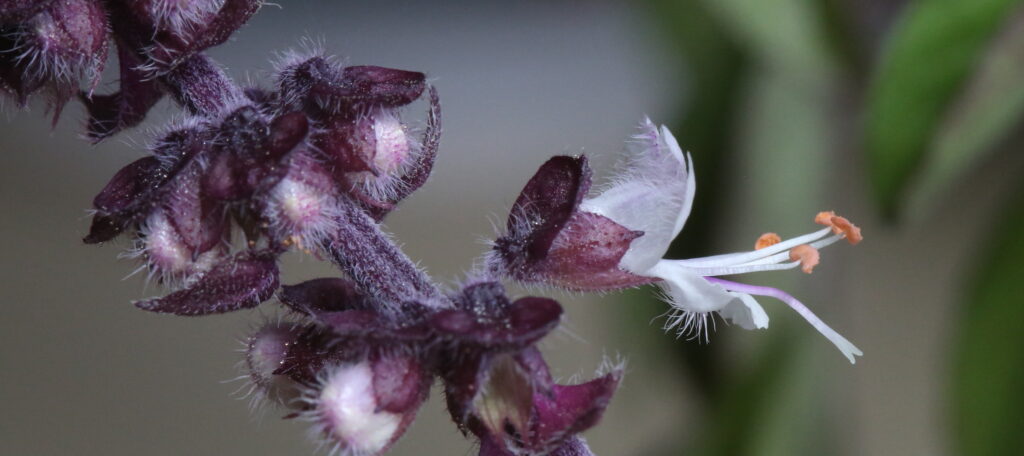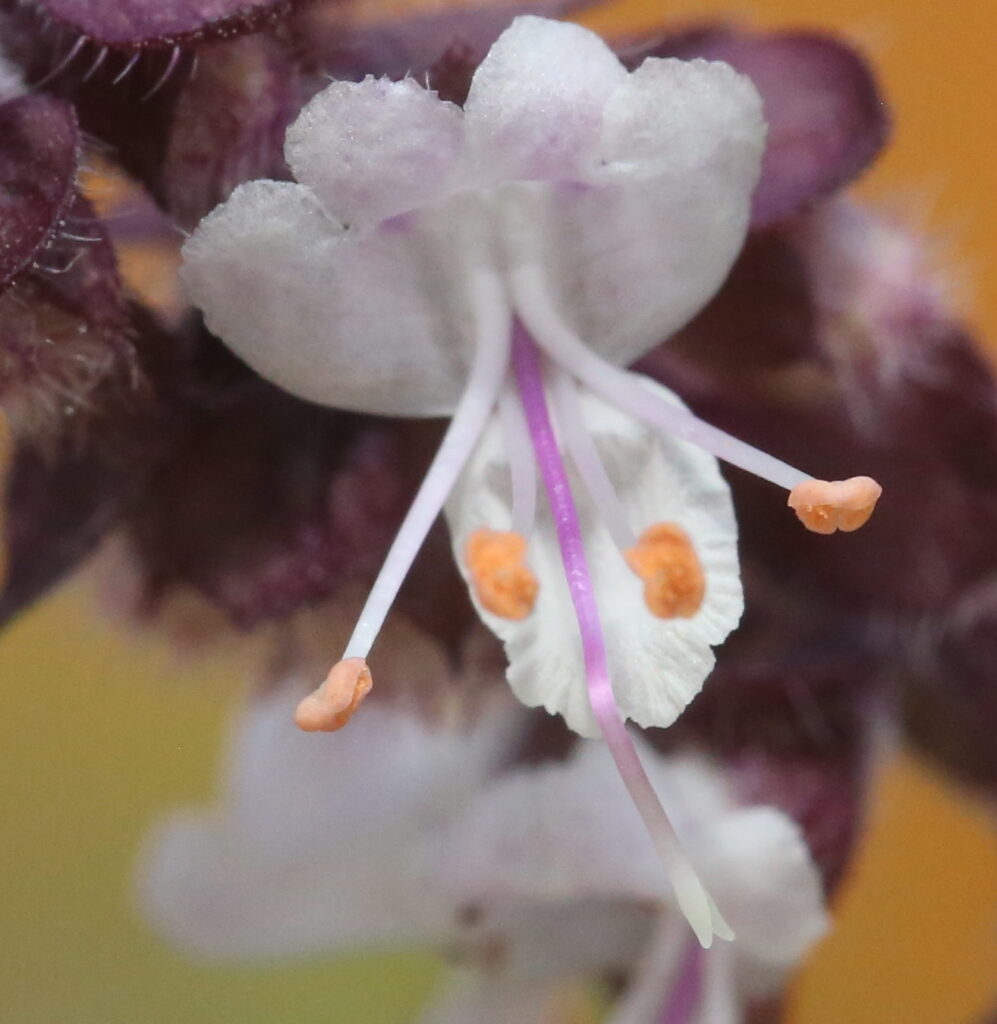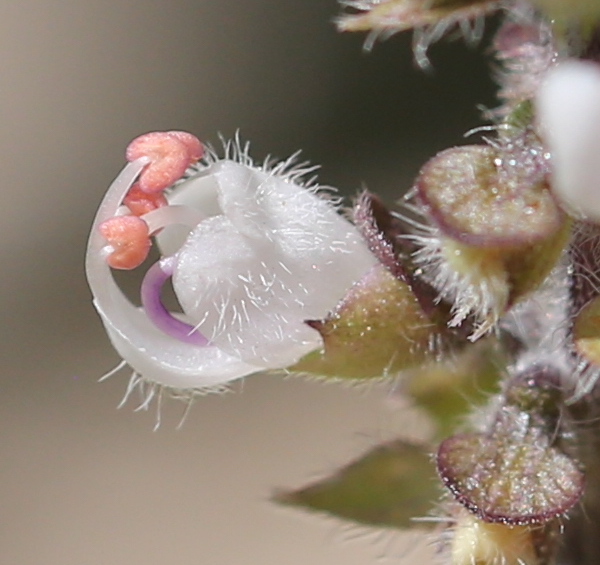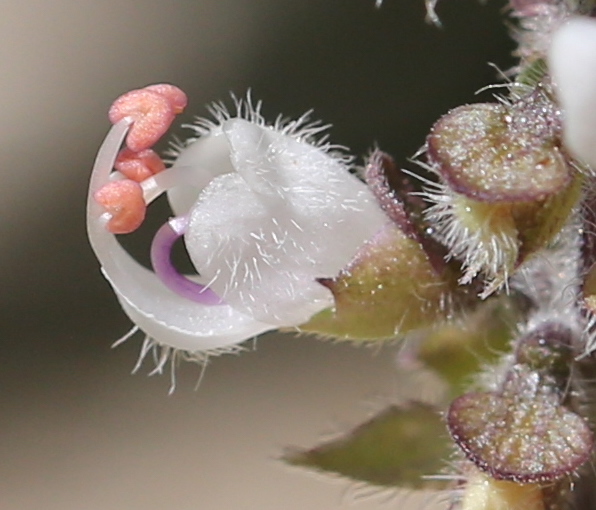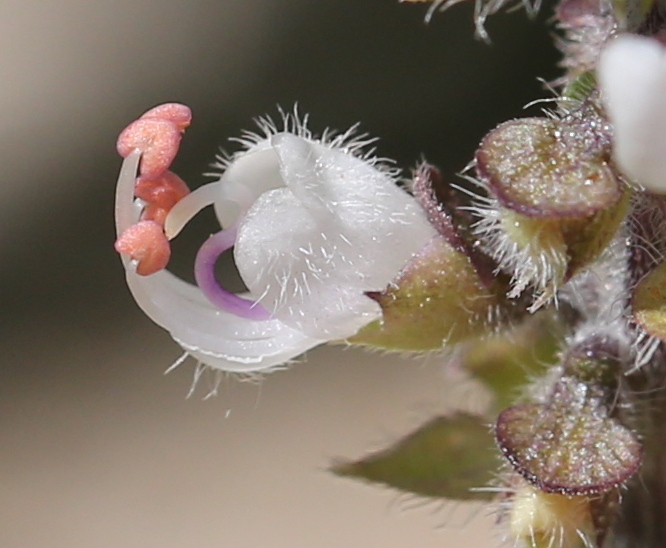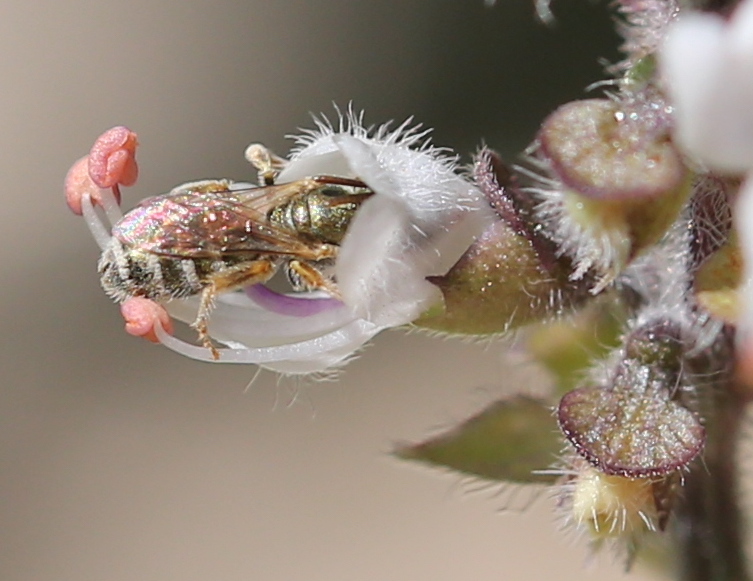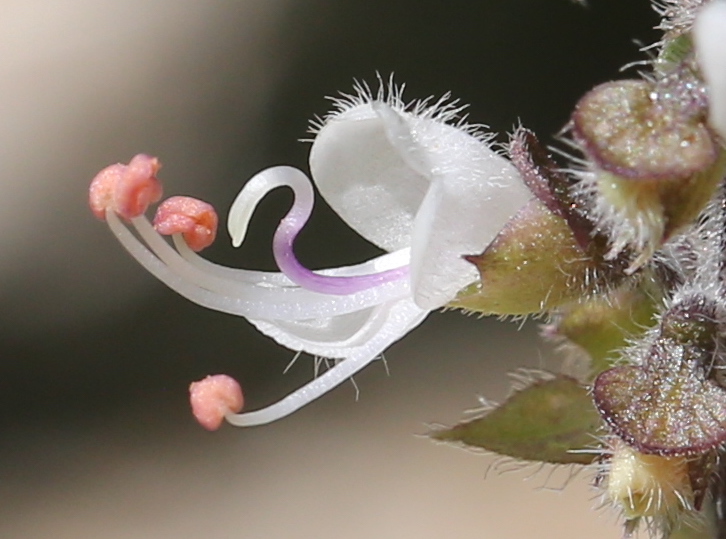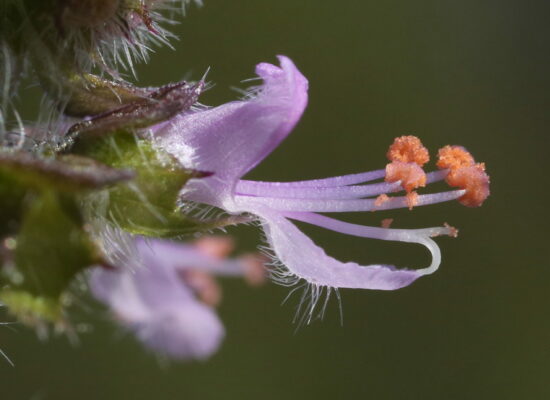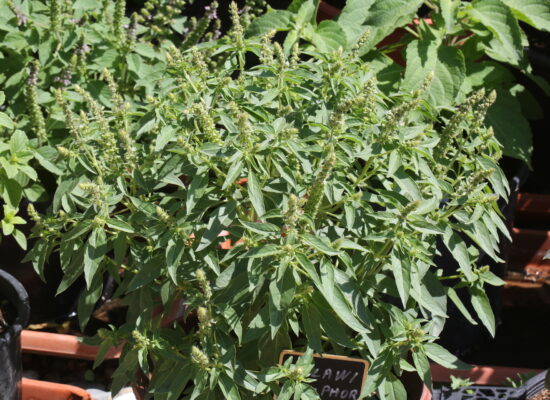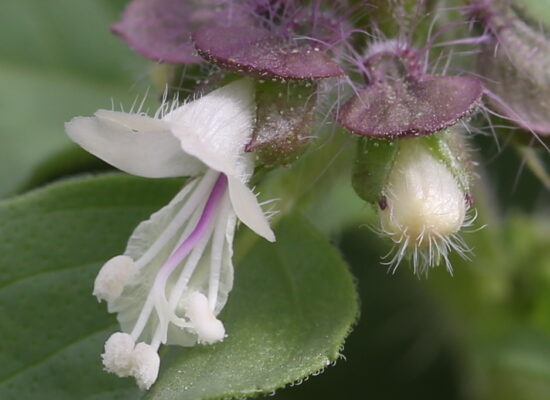Here’s a brief account of my discovery, in the garden, of two Basil plants – appearing to be of the “Cinnamon”, “Licorice” type, i.e. of the species Ocimum basilicum – with the relatively rare distinction of having orange pollen (and anthers)… just like Ocimum bisabolenum but, also, just like Ocimum kilimandscharicum.
Furthermore, in the fall, I realized that one of the two plants – which had a spread of nearly 1 meter and had grown in an alley with very compact soil – was not only a natural hybrid but an extreme anomaly in that a minority of branches produced white flowers while all the other branches produced very purple flowers. See photos below. To date, I have not found, on the Web, any information or study on basil plants with two colors of flowers depending on the branch.
These are clearly natural hybrids involving Ocimum basilicum and Ocimum kilimandscharicum.
Why not involving Ocimum bisabolenum? Because there is no testimony about the possibility of interspecific crosses, with the temperate Tulsi from Ethiopia , in 40 years of professional organic seed production… but there are with Ocimum kilimandscharicum.
I refer readers to my 2022 monograph on Ocimum bisabolenum: “Ethiopia is the source of the temperate Tulsi with its spicy scent of vanilla and myrrh… and red pollen – Ocimum bisabolenum”. [27]
The first conclusion to be drawn from this is to avoid cultivating these two species simultaneously for pure seed production.
The second conclusion is that such crosses, if fertile, can confer to Ocimum basilicum cultivars greater resistance to cold – and perhaps even greater resistance to basil blight.
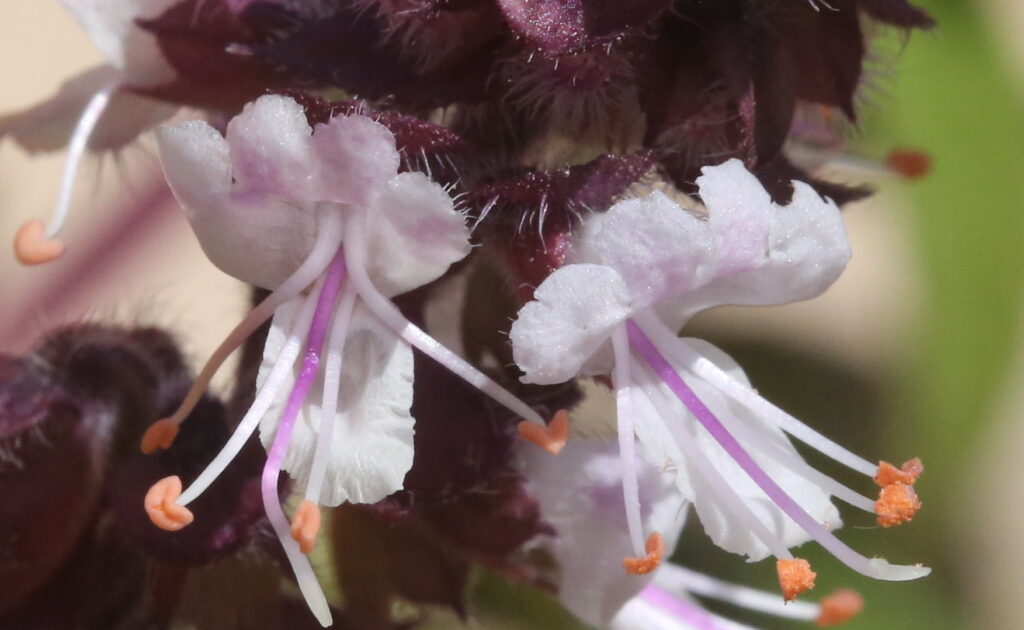
“spontaneous” and serendipitous cross… or a gift from the Mother-Earth? Photo by Xochi.
Genuine researchers have known for many, many years that basil’s downy mildew resistance genes can be found in Ocimum bisabolenum (called “Blue Spice” in their analyses), Ocimum americanum, Ocimum kilimandscharicum… but inter-specific crosses are non-existent – or almost.
On this subject, see my sections on basil blight in my monographs (in French) on Ocimum americanum [43] and Ocimum kilimandscharicum [44].
Xochi. September 26th 2024 Contact: Xochipelli@protonmail.com
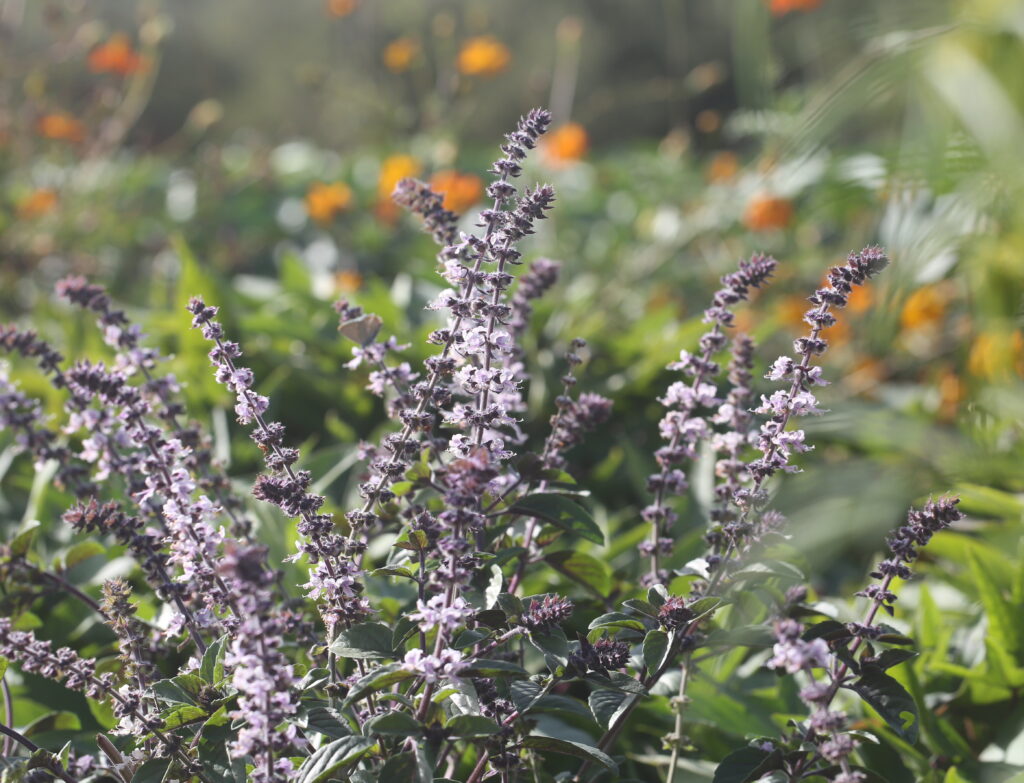
****************
This year, 2024, I didn’t sow any Basils and simply moved, or transplanted into large pots, the seedlings that volunteered during the summer in the garden. These seedlings come from seeds produced from 30 varieties, or species, of Ocimum – which self-seeded in 2022 or were broadcasted in the spring of 2024.
Thus, this year, I replanted around 50 seedlings of Ocimum bisabolenum, 1 seedling of Ocimum americanum var. americanum “Malawi Camphor”, 2 seedlings of Ocimum kilimandscharicum and, finally, 3 seedlings of Ocimum basilicum – or presumed to be.
Some forty Ocimum bisabolenum seedlings were replanted during the last days of August.
In this respect, I’ve noticed that the seeds of this species germinate above ground, in the shade or in the sun, and with relatively “temperate” temperatures… since “Ocimum bisabolenum” is native to the high plateaus of Ethiopia.
Consequently, seeds germinating in the shade of an older Ocimum bisabolenum plant – with its ample canopy – produce well-structured seedlings that sometimes reach 7 cm in height… without much sun.
Ocimum bisabolenum is a species endowed with mountainous energy and highly adapted to fluid telluric situations.
As a reminder, some of my Ocimum bisabolenum plants are in their 3rd summer of cultivation. It’s a basil that would make any permaculturalist swoon!
Regarding the 3 Ocimum basilicum seedlings– or presumed to be. The first gave a magnificent “Fino Verde” Basil plant.
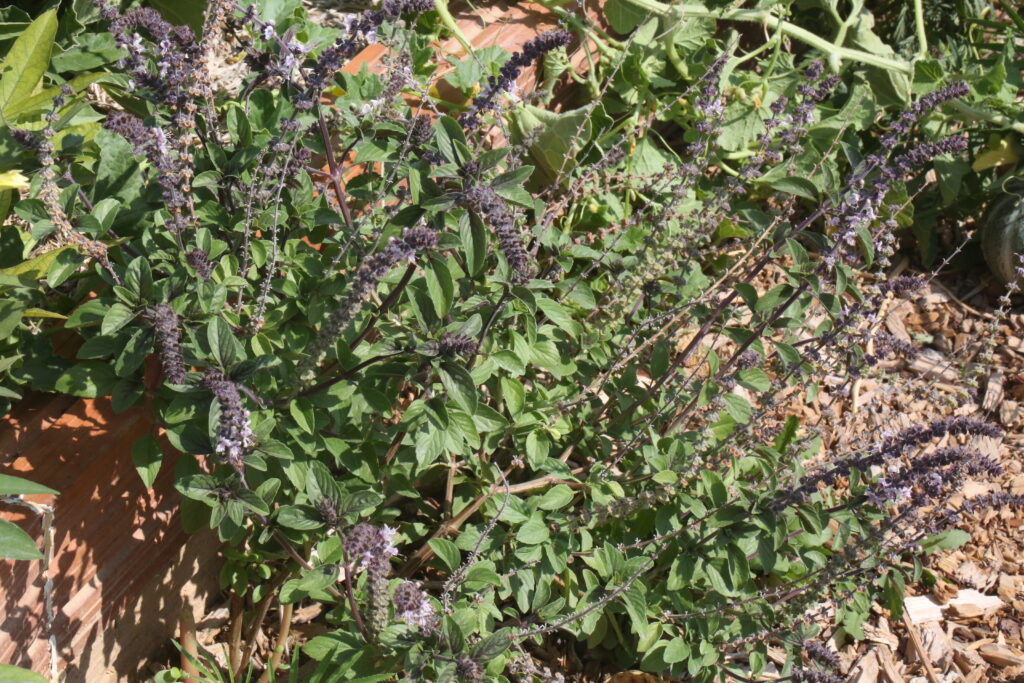
As for the other two, they surprised me by expressing themselves with orange pollen… whereas the color of Ocimum basilicum pollen is, strictly speaking, white – at least, there’s no reference on the Web to the contrary.
Two natural inter-specific hybrids – with orange pollen, no less – out of three plants: this is an immense gift from Mother Earth… because, statistically, it would take a whole lot of Universes!
In fact, it’s a charming response to my incessant requests to discover, in my garden, spontaneous and rare crosses between species that normally just rub shoulders – without the explosive fusion of pollen meeting an ovule.
As a reminder. Only intra-specific crosses are prevalent in the Ocimum genus. Spontaneous interspecific crosses are extremely rare.
PhDs who claim otherwise don’t have 30 years of seed production of all the major Ocimum species under their belts.
This explains why it is virtually impossible to transfer mildew resistance from various species to the highly susceptible Ocimum basilicum – apart from the “Mrihani” ecotype from Zanzibar.
Clearly, in my garden, these are two manifestations of natural hybrids involving Ocimum basilicum and Ocimum kilimandscharicum. Indeed, this would not be the first case – not to mention sterile cultivars such as “African Blue”, “Magic Mountain F1” and “Magic White F1” – since the Lucknow agronomy center, in India, has developed new, cold-resistant lines from natural hybrids involving these two species, growing in their gardens around 2010.
According to the 2020 study, “Generation of novelties in the genus Ocimum as a result of natural hybridization: A morphological, genetical and chemical appraisal”, [45] the two hybrids presented have orange pollen – but less bright than that of Ocimum kilimandscharicum.
On the other hand, one of the two hybrids has stamens the length of an Ocimum basilicum, while the other is the long length of an Ocimum kilimandscharicum.
Bear in mind that some ecotypes, or varieties, of Ocimum basilicum can have very long stamens that extend far beyond the corolla.
According to the authors: «The present study explored the two interspecific Ocimum hybrids originating through a serendipitous natural cross between O. kilimandscharicum and O. basilicum. These two novel Ocimum hybrids exhibited intermediate morphological features of two parental species. Inter simple sequence repeats (ISSR) analysis and DNA barcoding with the plastid non-coding trnH-psbA intergenic spacer region reaffirmed unambiguous parental identification and differentiation of these natural hybrids from other available Ocimum species. Consequently, gas chromatography-mass spectrometry-based metabolite profiling of two hybrids identified them as specific chemotypes with the presence of a unique blend of specialized metabolites from the parental species, which are either rich in terpenes or phenylpropanoids. Additionally, expression analysis of key genes from terpenoid and phenylpropanoid pathways corroborated with differential metabolite accumulation. Thus, these two Ocimum hybrids represented novel chemotypes… ».
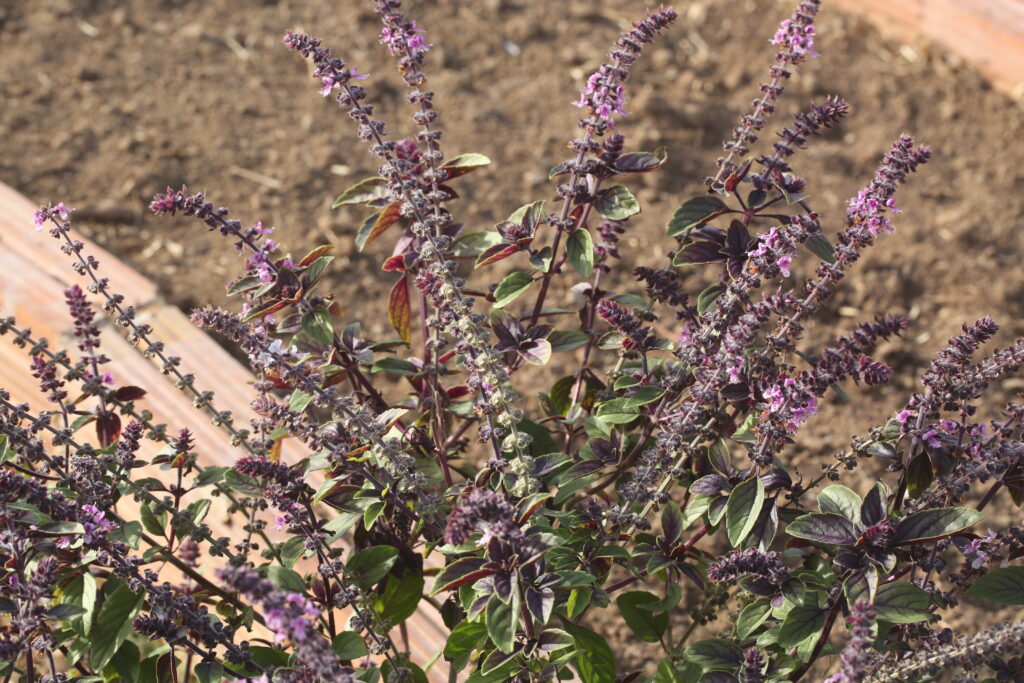
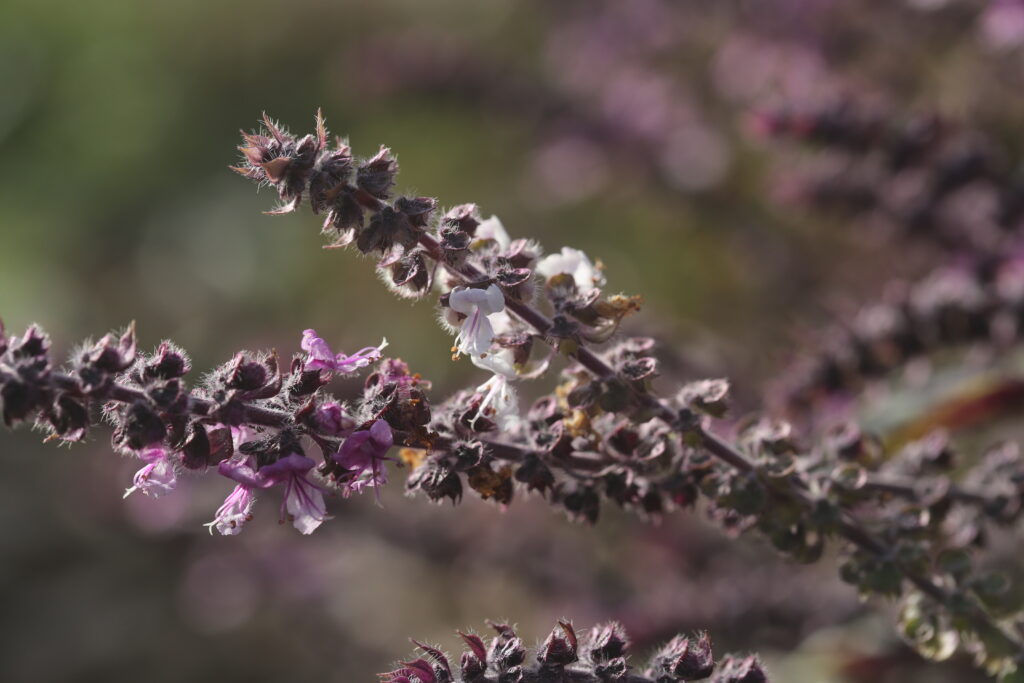
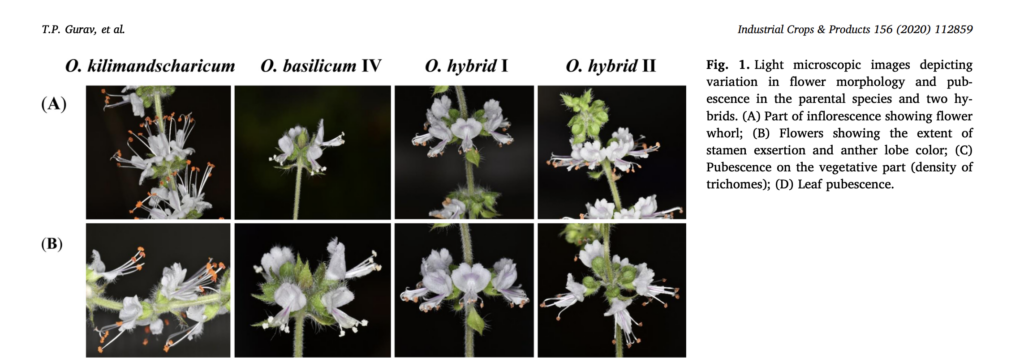
In my garden, the first natural hybrid, in the ground, is a large plant – which I’m going to try to replant… because it grew right in the middle of a very packed driveway covered with olive bark. As for the second, it’s in a pot.
Both plants are completely purplish: the young leaves and stems.
Flower morphology. In the first hybrid, in the open ground, the corolla core, style and stamens are purplish. Style and stamen length are between those of Ocimum kilimandscharicum and Ocimum basilicum.
I started to gather seeds which I will sow, next season ,to check if they are fertile.
In the second hybrid, in pots, the corolla is relatively white, with a slight mauve tinge. The pistil is purple, but the stamens are white. Style and stamen length are more in line with those of Ocimum kilimandscharicum.
Here is a sequence of pictures (from Xochi) illustrating the delicate opening of a flower of Ocimum kilimandscharicum. Enjoy!
